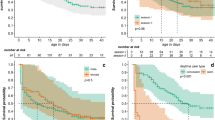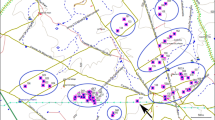Abstract
Information on reproductive biology of the European hare (Lepus europaeus) in different environmental and landscape conditions comprises part of fundamental knowledge regarding species’ adaptive responses as well as many aspects of its biology. Most of the studies conducted on European hare reproduction are confined to midlatitude and northern populations, whereas no data exist on the indigenous southern populations. Here, we present information on reproductive characteristics of European hares inhabiting Mediterranean ecosystems on the island of Crete, Greece for two successive hunting seasons. Although the annual reproductive cycle of the species is well known, with an autumn sexual inactivity, the duration of this period is subjected to fluctuations in different years and for different areas. According to our data, hare populations of Crete present an autumn–early winter reproductive activity with high proportions of pregnant females observed in all the months of the study. Furthermore, the estimated mean litter size (1.54 SE ± 0.07) while signed to the lowest values ever observed for European hares is similar to values obtained in continuous breeding species of the same genus, Lepus granatensis, Lepus corsicanus, Lepus (capensis) mediterraneus, and Lepus capensis also inhabiting warm climates. In conclusion, our results suggest that Cretan European hare populations exhibit a reproductively active period during autumn–early winter where proportions of pregnant females and litter size give a strong indication of a continuous reproduction throughout the year.

Similar content being viewed by others
References
Alves PC, Gonçalves H, Santos M, Rocha A (2002) Reproductive biology of the Iberian hare, Lepus granatensis, in Portugal. Mamm Biol 67:358–371
Antoniou A (2008) Population structure of the brown hare in Balkans. PhD thesis, University of Crete
Bensinger S, Kugelschafter K, Eskens U, Sobiraj A (2000) Untersuchungen zur jährlichen Reproduktionsleistung von weiblichen Feldhasen (Lepus europaeus Pallas, 1778) in Deutschland. Z Jagdwiss 46:73–83
Ben Slimen H, Suchentrunk F, Shahin AB, Ben Ammar Elgaaied A (2007) Phylogenetic analysis of mtCR-1 sequences of Tunisian and Egyptian hares (Lepus sp. or spp., Lagomorpha) with different coat colours. Mamm Biol 72(4):224–239
Bonino N, Montenegro A (1997) Reproduction of the European hare in Patagonia, Argentina. Acta Theriol 42:47–54
Broekhuizen S, Maaskamp F (1981) Annual production of young in European hares (Lepus europaeus) in the Netherlands. J Zool (London) 193:499–516
Cary J, Keith LB (1979) Reproductive change in the 10-year cycle of snowshoe hares. Can J Zool 57:375–390
De Marinis A, Trocchi V (2007) Reproductive biology of Sardinian hare Lepus (capensis) mediterraneus revealed by stained placental scars. Hystrix It. J. Mamm. (n.s.) Supp.:77
De Marinis A, Trocchi V, Mangiafico S (2007a) First data on reproductive biology of Italian hare Lepus corsicanus. Hystrix It. J. Mamm. (n.s.) Supp.:78
De Marinis A, Trocchi V, Mangiafico S, Fassò C, Mallia E (2007b) Strategie riproduttive in tre specie di Lepre (Lepus sp. pl.) in Italia. Conservazione di Lepus corsicanus De Winton, 1898 e stato delle conoscenze, de Filippo et al. (a cura di), 2007, IGF publ.:75–81
Flux JE (1967) Reproduction and body weights of the hare, Lepus europaeus Pallas, in New Zealand. New Zealand J Sci 10:357–401
Flux JE (1981) Reproductive strategies in the genus Lepus. In: Myers K, MacInnes CD (eds) Proceedings of the world lagomorph conference. Ontario, University of Guelph, pp 155–174
Frylestam B (1980) Reproduction in the European hare in southern Sweden. Holart Ecol 3:74–80
Hackländer K, Frisch C, Klansek E, Steineck T, Ruf T (2001) Die Fruchtbarkeit weiblicher Feldhasen (Lepus europaeus) aus Revieren mit unterschiedlicher Populationsdichte. Z Jagdwiss 47:100–110
Hansen K (1992) Reproduction in European hare in a Danish farmland. Acta Theriol 37:27–40
Hewson R, Taylor M (1975) Embryo counts and length of the breeding season in European hares in Scotland from 1960–1972. Acta Theriol 20:247–254
Kasapidis P, Suchentrunk F, Magoulas A, Kotoulas G (2005) The shaping of mitochondrial DNA phylogeographic patterns of the brown hare (Lepus europaeus) under the combined influence of Late Pleistocene climatic fluctuations and anthropogenic translocations. Mol Phyl Evol 34:55–66
Keith LB (1981) Population dynamics of hares. In: Myers K, MacInnes CD (eds) Proceedings of the world lagomorph conference. Ontario, University of Guelph, pp 395–440
Keith LB, Rongstad OJ, Meslow EC (1966) Regional differences in reproductive traits of the snowshoe hare. Can J Zool 44:953–961
Kovács G (1983) Variability of fecundity rates in a population of European hare. In: Spenik M, Hell P (eds) IUGB XVII, Strbske Pleso, pp 450–458
Lincoln GA (1974) Reproduction and March madness in the brown hare, Lepus europaeus. J Zool (London) 174:1–14
Marboutin E, Bay Y, P, éroux R, Mauvy B, Lartiges A (2003) Population dynamics in European hare: breeding parameters and sustainable harvest rates. J Appl Ecol 40:580–591
Martinet L, Legouis JJ, Moret B (1970) Quelques observations sur la reproduction du lièvre européene (Lepus europaeus Pallas) en captivité. Annls Biol Anim Bioch Biophys 10:195–202
Matzarakis A, Karatarakis N, Sarantopoulos A (2005) Tourism climatology and tourism potential for Crete, Greece. Annalen der Meteorologie 41:616–619
Mitchell-Jones AJ, Amori G, Bogdanowicz W, Krystufek B, Reijnders P, Spitzenberger F, Stubbe M, Thissen J, Vohralik V, Zima J (1999) Atlas of European mammals. Academic, London, pp 166–168
Parkes JP (1989) Annual patterns in reproduction and perirenal fat of hares (Lepus europaeus) in sub-alpine Canterbury, New Zealand. J Zool (London) 217:9–21
Pépin D (1987) Dynamics of a heavily exploited population of brown hare in a large-scale farming area. J Appl Ecol 24:725–734
Pépin D (1989) Variation in survival of brown hare (Lepus europaeus) leverets from different farmland areas in the Paris basin. J Appl Ecol 26:13–23
Pépin D, Meunier M, Angibault J (1981) Etude de la reproduction du lièvre (Lepus europaeus) dans le Basin Parisien. Bull ONC Scientifique et Technique 11:3–26
Pèvet P (1987) Environmental control of the annual reproductive cycle in mammals.. In: Pèvet P (ed) Comparative physiology of environmental adaptations. vol. 3. ESCP Conference, Strasbourg, pp 82–100
Pielowski Z (1976) Number of young born and dynamics of the European hare population. In: Pielowski Z, Pucek Z (eds) Ecology and management of European hare populations. Polish Hunting Association, Warszawa, pp 75–78
Raczyński J (1964) Studies on the European hare V: reproduction. Acta Theriol 19:305–352
Reynolds JK, Stinson RH (1959) Reproduction in the European hare in southern Ontario. Can J Zool 37:627–631
Sarris A, Maniadakis M, Lazaridou O, Kalogrias V, Bariotakis M, Pirintsos S (2005) Studying land use patterns in Crete island, Greece, through a time sequence of landsat images and mapping vegetation patterns. WSEAS International Multiconference on Int Conf on Environment, Ecosystems and Development (EED05)
Stott P, Harris S (2006) Demographics of the European hare (Lepus europaeus) in the Mediterranean climate zone of Australia. Mamm Biol 71:214–226
Stott P, Harris S, Wight N (2008) Fertility and infertility in the European hare Lepus europaeus in Australia. In: Alves PC, Ferrand N, Hackländer K (eds) Lagomorph biology: evolution, ecology and conservation. Springer, Berlin, pp 225–240
Stroh G (1931) Zwei sichere Altersmerkmale beim Hasen Berl. Tierärztl Wschr 12:180–181
Suchentrunk F, Willing G, Hartl GB (1991) On eye lens weights and other age criteria of the Brown hare (Lepus europaeus Pallas, 1778). Z Säugetierkd 56:365–374
Suchentrunk F, Michailov C, Markov G, Haiden A (2000) Population genetics of Bulgarian brown hares Lepus europaeus: allozymic diversity at zoogeographical crossroads. Acta Theriol 45:1–12
Zar J (1996) Biostatistical analysis, 3rd edn. Prentice-Hall, New Jersey
Acknowledgments
We would like to thank all hunters and Hunting Associations of Crete and especially Mr. M. Fragiadoulakis (president of the 1st Hunting Association of Irakleio) for providing samples and sharing their experience. We thank K. Lika, M. Giannoulaki, N. Lampadariou, and A. Parmakelis for helping on the statistical analysis. We would also like to thank N. Poulakakis and A. Parmakelis for their suggestions on an earlier draft of this manuscript. Finally, we are indebted to the reviewer for very constructive comments. This study was performed in accordance with current Hellenic legislation.
Author information
Authors and Affiliations
Corresponding author
Additional information
Communicated by C. Gortázar
Rights and permissions
About this article
Cite this article
Antoniou, A., Kotoulas, G., Magoulas, A. et al. Evidence of autumn reproduction in female European hares (Lepus europaeus) from southern Europe. Eur J Wildl Res 54, 581–587 (2008). https://doi.org/10.1007/s10344-008-0182-y
Received:
Revised:
Accepted:
Published:
Issue Date:
DOI: https://doi.org/10.1007/s10344-008-0182-y




